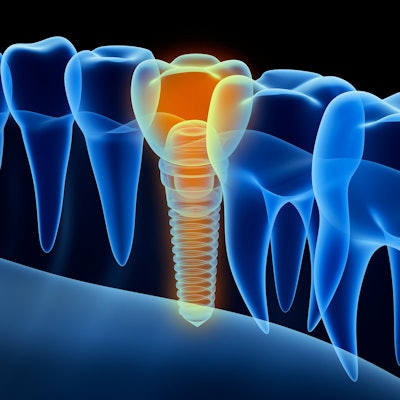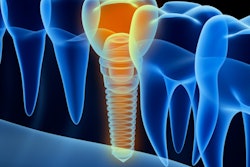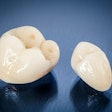
Patients reported higher satisfaction with a digital workflow for creating a single implant-supported posterior crown than a conventional workflow in a randomized clinical trial published in the Journal of Dentistry.
Patient satisfaction was high for both types of workflows, but the digital method particularly excelled at preventing an irritating taste. Patient satisfaction was also high no matter whether they received a lithium disilicate or polymer-infiltrated ceramic restorative material.
"Within the limitation of this study, both completely digital and conventional protocols provided great levels of patient satisfaction in implant rehabilitation of single-tooth gaps in posterior sites with monolithic implant crowns," wrote the authors, led by Chatchai Kunavisarut, an assistant professor at the Mahidol University Department of Advanced General Dentistry in Bangkok (J Dent, October 30, 2021).
The randomized controlled trial analyzed patient-reported outcome measures (PROMs) for 40 healthy patients who required one posterior implant-supported crown. The goal was to evaluate patient satisfaction for the impression process and the final outcome.
For the trial, half of the patients underwent a completely digital workflow, including impressions taken with an intraoral scanner, while the other half were assigned to a conventional workflow with conventional impression techniques. The intraoral scan included quadrantlike scanning of implant sites, including opposite sites and bites.
One prosthodontist performed all impressions for the patients, and a second prosthodontist tried and placed the final implant restorations. An experienced technician designed and manufactured the implant-retained fixed dental prostheses.
The team used a CAD/CAM process to design and manufacture all crowns used in the study. Clinicians used two types of restoration materials for patients, both of which can be manufactured chairside.
Patients in all groups reported high satisfaction with the impression process and treatment outcomes. They gave high scores for impression duration, comfort, anxiety, nausea, and pain, as well as implant functionality, esthetics, and cleanability.
However, the digital group reported significantly less taste irritation during the impression process than the conventional one. In addition, of the two crowns that had to be remade for the trial, both were for patients with the traditional workflow. One crown fractured during the try-in period, while the other had insufficient interproximal contacts.
A prosthodontist also evaluated the final implant restorations and rated the final outcome as high for all patients. The crowns manufactured with the digital process scored slightly higher than those manufactured with the conventional one.
While the study assessed patient satisfaction one week after treatment, the results are still important, since patient satisfaction is one of the most crucial factors for determining treatment success, the authors noted.
"Nowadays, the expectation in reconstructive dentistry is beyond functional rehabilitation of missing teeth with naturally look-alike esthetics and oral health plus convenience during every treatment stage," they wrote.



















